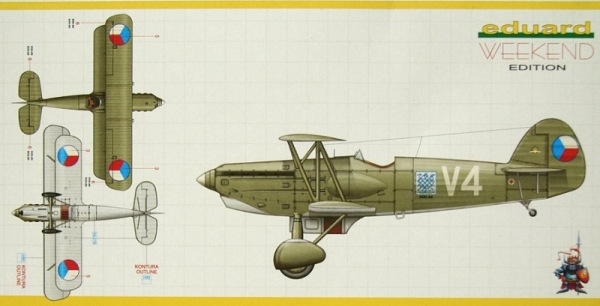

The Avia B-534 aircraft was built around the engine Hispano HS-12Ycrs which Avia bought in 1932. The origins of the aircraft goes to previous design of Frantisek Novotny, Avia B-34. The aircraft had very fine shape, fixed undercarriage and open cockpit.
The aircraft was aproved by Czechoslovak army and the squadrns got the first aircraft in 1934. Further development continued and there were altogether four series, the last more distinctive, with closed cockpit, different position of the coolers and instead of tail skid appeared the wheel.
By the Munchen crises the type was obsolete but after occpation of Czechoslovakia, the Luftwaffe used it for towing, some stayed in Slovak Air Force, some were sold to Hungary and Bulgaria and served as a trainers. During the Slovak National uprising pilot Ciprich shot down Ju-52 on one of the remaining B-534, it is supposed to be last victory of the biplane in WWII.
There are no original survivers but in 1970' was one aircraft rebuild by enthusiast and now is on exhibition in Air muzeum in Kbely near Prague, Czech republic and although there are some differences, it serves as a good reference for those who like "wind in wires".
More about Avia B-534 on wikipedia
The Eduard model comes in a solid box that protects the parts. As all the Eduard's weekend editions, this one lacks the PE parts as well as the masks and there are decals for only one schema and you have its colour reference on the box. The quality is, I would say, excelent, you actually start with the fuselage internal construction :). The instruction are in Czech and English, with pretty clear diagrams.
I followed the instructions so I started the cockpit. As I have even the "normal" edition of the Avia B-534 4. series kit which comes with PE set with two instrument panels (one for 3. series, one for 4. series), I could use the one for 3. version on this one. and the photoeched internal construction in the fuselage. Some of the PE parts I made myself. I glued the cockpit to the left fuselage part as I did with the internals of the cooler. It was painted all silver with brown and red-brown details - handles, seat adjusting wheel, seat cushion, fler and map pockets.
Then I glued together two halves of fuselage in 3 steps, as there was a minor mishape just behind the cockpit and it is very useful that the front top comes as separate part, as you can easily access the gluing edges from inside. when this was done and dried, the axe of teh screw was added and the top of the engine cover closed the front of the fuselage nicela, with need of only little bit of putty and sanding.
While the fuselage was left to dry, I put together stabilizers the are separated glued them in "droped" position and painted wheels (I actually painted the skies as well, as I wasn't decided what version I would use). I drilled the little holes for the wires to the wings as well (and to the fuselage too).
The Avia B-534 is a biplane that was worthwhile kit to add to my collection of Bulgarian Air Force section in view of its popularity and also with pilots who flew it in various air forces that it served. There was rebuilded one B-534 in 1970's by enthusiast around the Aviation Museum in Kbely, near Prague and is accommodated there, and not only for this the muzeum is worth visiting.
June 2009